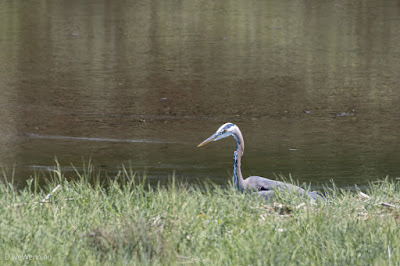Heron Luncheonette
On Memorial Day I hiked around the Kukutali Preserve. It is a favorite and convenient spot for me, quick and easy to get to and I always find something interesting there. At the end of the hike, I headed back along the tombolo connecting Kiket Island to the mainland. There is a lagoon on the north side of the tombolo. Over the bank separating the roadway from the lagoon, I spotted a Great Blue Heron (Ardea herodias) giving me the eye.
In itself, seeing a heron around here is not unusual. What did strike me as odd, I was well inside the "escape zone" from which herons will usually flee, barking in protest. This one did not flee, however, but remained in place watching me.
As I continued along the tombolo, I got even closer and was able to get a better view of the bird. It was wading belly deep in the lagoon. Still, it did not flee from me. It just stood there motionless.
Then, quite suddenly, the bird plunged its head into the water revealing what was going on. This heron was having lunch. Food was apparently more important than any concerns about the human invading its space.
The feeding technique I was observing revealed the perfection of the Great Blue Heron's anatomy. It has long legs for wading, a long flexible neck for plunging after fish or other aquatic prey and a spear-shaped beak for grabbing and holding its prey. A compact, muscular body keeps it all in balance. The bird is a skilled fishing machine, and based on what I witnessed, it never missed. No energy was wasted on failed attempts.
Down the hatch. The anatomy that is so perfect for catching fish makes it a slow and awkward flier. This is a big, heavy bird that struggles a bit launching into flight. Like a Boeing 747, it needs a long runway. They look ungainly in flight with long legs extending behind and the neck crooked into an 'S' shape. Their huge wings flap slowly making them appear to be galumphing through the air. Their flight is more bouncing than soaring. This difficulty with flight may account for why they readily flee when catching sight of people. Better safe than sorry.
I remained still and continued to watch the bird while taking photos of the action. Now my presence seemed to be of no concern as it peered directly into the water motionless.
Another successful catch. Young Perch appeared to be the prey.
The lagoon is classified as a pocket estuary (.pdf). It is circular in shape with only a narrow opening into Skagit Bay. Saltwater enters during high tides, while fresh water is supplied by upland runoff. It provides important, sheltered habitat for the Skagit River run of Chinook Salmon. After hatching upstream, the fry will spend time here adapting to salt water before heading out into the Pacific Ocean. Only the swift and smart will escape from the herons' fast food restaurant.
I gave some thought to why this heron decided to stand its ground rather than fleeing as I approached:
- Food was more important than a possible human threat
- Birds can become more tolerant to humans in parks and recreation areas
- I was visible to the bird at all times
- I avoided obvious staring or any posture that would imply stalking or hunting
- The bird always had an easy escape route
- This particular bird may be bolder than most
Whatever the reason, I'm glad the heron didn't flee. I enjoyed the encounter. Observing this behavior up close turned out to be an experience to remember.








